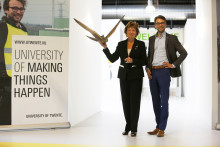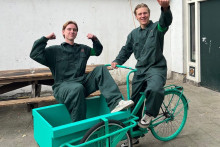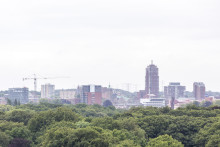Ajax football club and TV talent show The Voice of Holland have come under media scrutiny in recent weeks following reports of inappropriate behaviour, but higher education is no stranger to this issue. Last year, the Inspectorate launched an investigation into study programmes at a number of institutes. Problems in art and fashion programmes were particularly widely reported.
The government has now announced firmer action to combat sexually inappropriate behaviour, but there are also other forms of unacceptable behaviour such as intimidation and discrimination.
Respect
In the meantime, the Inspectorate of Education is taking action to address the issue. The results of a questionnaire completed by over 1,500 students have been set out in a concise fact sheet. It reveals that by no means all incidents are reported.
Most respondents say they feel safe on their study programme. The majority are not afraid to express their opinion and say that teaching staff treat them with respect. But 7 percent do not share this view. And 8 percent of the students say they have encountered bullying and exclusion during their studies.
Discrimination when looking for a work placement appears to be less prominent (62 percent have no opinion), but it does happen: over one in five say they have heard of examples on their study programme or have experienced it themselves.
33,000 students
And inappropriate behaviour? Two percent of students prefer not to comment, while four percent say they have experienced this kind of behaviour personally. Viewed as a representative sample of the student population, that four percent (60 of the 1,500 respondents) stands for a total of 33,000 students.
‘A shocking figure’, says Ama Boahene of the Dutch Student Union. ‘Action is needed to prevent students from becoming victims of unacceptable behaviour.’ She wants to see measures such as improved reporting procedures and training in social safety.
Her counterpart Lisanne de Roos of the Dutch National Students’ Association advocates better monitoring of social safety: ‘Every student who has to go through something like this is one too many.’
The results certainly seem to highlight the need for monitoring. The students say that over half of inappropriate behaviour cases involve a member of staff at the educational institution and that the problem largely goes unseen. Although the majority of victims discuss an event like this with someone inside or outside the institution, a quarter take no action whatsoever: only three of the sixty respondents lodged a formal complaint. One of them went to the police.
Why do so few students lodge a formal complaint? Half say they think there would be no point, while almost one in five say they do not know where to lodge a complaint. Some students responded: ‘My complaint wasn’t really that serious’.
The Inspectorate spoke in greater detail to a few students. One of them said: ‘I talked to the manager of the lecturer who intimidated me and to the confidential counsellor. The process was so uncomfortable that I didn’t lodge a formal complaint.’ Another said: ‘I was advised not to tell other people about my experience, especially the media.’
Limitations
The Inspectorate admits that the survey has its limitations, not least because of the low response rate of 15 percent; the survey was distributed to 10,000 students at universities and universities of applied sciences. It is currently considering repeating the survey with a view to obtaining a response from ‘target groups that are hard to reach’.
Too few students with a migration background completed the questionnaire to be able to say anything about that group. Students from Behavioural & Social Sciences and Economics are underrepresented too, as are students who have been taking a study programme for over four years.
Nevertheless, the Inspectorate concludes that institutions need to raise the profile of complaints procedures and make them more easily accessible. The Inspectorate will soon issue a separate fact sheet on what students think of the complaints procedures.
Monitoring
Moreover, there is a need for higher education to monitor social safety more effectively, both nationally and within individual institutions. ‘Ensuring that the figures are transparent and identifying the risk factors can contribute towards social safety in higher education in the Netherlands’, the Inspectorate believes.
And if indications of an unsafe social situation emerge, it adds, an independent investigation into the organisational culture is required.
This survey did not provide a definition of ‘inappropriate behaviour’. It was up to the students to interpret the term for themselves. This is only the first in a series of surveys, a spokesperson says. The Inspectorate will be carrying out a further investigation of the fashion and arts programmes. ‘In that survey, we will of course be taking an in-depth look at current issues and what has been done to counter them.’







